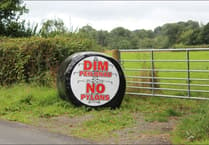Editor: The editor’s code states that “the press should take care not to publish inaccurate, misleading or distorted information” and also “must distinguish clearly between comment, conjecture and fact”.
Two recent short pieces included in the Cambrian News by Patrick O’Brien do not, in my opinion, conform to this code. They are emotive opinion pieces, purporting to be fact whilst being far from it. The first (Are those who ring merlin chicks doing more harm than good?,31 August) deliberately omits crucial pertinent information that may have radically altered the reader’s take on the story.
The five Merlin chicks which he states were “killed by ringers” were actually predated four to five days after the visit on which they were ringed - something he fails to mention, presumably because it doesn’t fit with the narrative. I can provide you with photographic evidence of the chicks’ stage of feather growth at both ringing and after they had been predated to prove this. Whilst their deaths are undoubtedly tragic they were not caused as a direct result of the ringing, a fact even acknowledged by the main complainant and I assume the originator of the “story”.T
he incident was reported to and investigated by the licensing authorities - Natural Resources Wales and the British Trust for Ornithology and no fault was found in either the ringing process or the decision to ring the brood.
The only ‘evidence’ for the ringing having had some bearing on the outcome of the nest is that they weren’t predated in the previous three years. I wasn’t hit by a car in the previous three days but it doesn’t mean I won’t be tomorrow! In an earlier email to me the complainant acknowledges that the nest was very ‘open’, i.e. not well concealed and I too was concerned at this aspect myself when I first saw it.
It is likely that the growing brood, increasingly active in the nest as they practised flapping their wings, attracted the attentions of a passing fox.
The follow-up article (... and more tales of ringing woes, 14 September) gain mentions unsubstantiated claims against unnamed individuals about killing Barn Owl chicks. It also includes an assertion by the same un-named retired farmer that the survival of the Red Kite in Mid Wales was only due to it being left alone by “do-gooder” conservationists. I was actually the main initiator, one of the founding members and currently Chairman of the Welsh Kite Trust, which undertook extensive conservation work on Red Kites (including ringing the vast majority of young kites reared) from 1994-2010, during the period of rapid growth in the species’ population. I can quite categorically state from personal experience that if we had “just left them alone” as suggested, we would not have seen the amazing resurgence of the species in Wales and it wouldn’t now be lauded as the world-beating conservation success story it is.
Two of my co-founders of the Trust, Peter Davis and Peter Walters-Davies, both now deceased unfortunately, were given MBE’s for their hands-on work on Red Kites by her late majesty Queen Elizabeth II. It is ironic that in some circles we are now criticised for what we did because there are now “too many” of them!In these days of rapid change, when even once common species are on the brink, we need conservation tools such as hands-on management, nest monitoring, ringing and land-manager engagement to help secure their future. Many people confuse not knowing something is doing badly with success. Because they don’t know their Curlews/Kites/Barn Owls have died they assume everything is going OK. This is the ostrich approach!It is only through close monitoring that we discover problems such as the impact of rodenticides on Red Kites and Barn Owls, the impact of increased mammalian predators on ground-nesting birds, the devastating effect silage cuts have for nesting curlews and the mismatch of food availability and breeding cycle in many migrant species due to global warming. These findings can then inform future management and policy.T
here are many reasons the Barn Owls mentioned in the piece may have died, rodenticide poisoning, heat-stroke, disease or even starvation following the death of an adult but I can quite confidently say that they did NOT die from simply having been ringed. I regularly ring Ospreys at the live-streamed Welsh nests.
My activities, and the outcomes, are filmed and posted online for all to see. I can provide numerous examples of birds (of several species) that I ringed over 20 years ago that are still alive and well. The oldest ringed bird in the BTO scheme, a Manx Shearwater, lived for over 50 years after it was first caught.Many people will never view human ‘interference’ as acceptable for wild animals. There is, I think, a much larger alternative view point, held by the silent majority, that we need to know as much as we can in order to save what we have. Research in this country is, quite rightly, tightly regulated. It is only allowed to be conducted by trained individuals. The fact that these individuals are often volunteers, who enjoy undertaking these activities as a ‘hobby’, rewarded by helping to save yet another species from being lost, should not be viewed negatively. It is a huge asset to the nation’s conservation programmes that there are such dedicated and highly skilled individuals who will actually spend not insubstantial amounts of their own time and income supporting these projects. In modern parlance it is referred to as ‘citizen science’ or ‘public engagement’ and is one of the major requirements of funding bodies currently.
We all know that the government’s commitment to conservation is limited, especially financially.Misleading and emotive headlines and text such as in these two pieces, is cheap and easy but it undeservedly slurs and undermines essential conservation work, both past and present, and those making valuable contributions towards saving our wildlife for all.
Tony Cross, Llandrindod Wells





Comments
This article has no comments yet. Be the first to leave a comment.